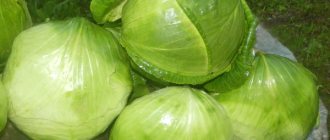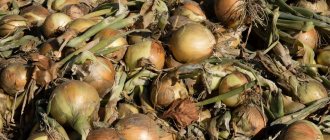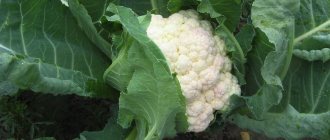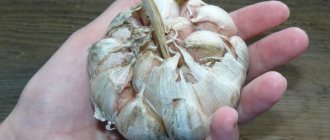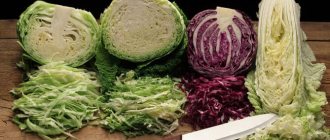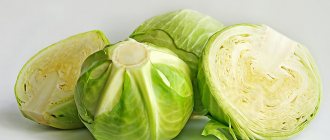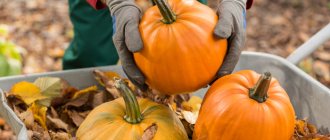When is it necessary and possible to collect heads of cabbage in the garden, at what temperature?
It’s easy to determine that a head of cabbage has matured and it’s time to cut it:
- when the forks are compressed, it produces a characteristic crunch,
- the leaves have acquired a bluish tint,
- the top of the head of cabbage became smooth and shiny.
When planning harvest, in addition to external signs of ripeness, you need to pay attention to weather conditions.
Ideal weather for cutting cabbage heads:
- no precipitation,
- partly cloudy,
- air temperature from +4 to +8°С.
It is very important to harvest cabbage before the first frost occurs. Already at temperatures below -6° we can talk about product spoilage.
Depending on the ripening period
The time to harvest cabbage largely depends on the ripening time of each specific variety.
- Early varieties (for example, June) are harvested on the ninetieth day after planting the seedlings (starting from the end of June). Early varieties cannot be kept in the garden for long, as the heads of cabbage become overripe and begin to crack and rot.
- Mid-season varieties (for example, Slava or Kupchikha) are stored for up to five months. Harvesting begins in September (one hundred and forty days after planting the seeds).
- Late, or winter, varieties (for example, Crumont or Amager) are the best option for long-term storage. The collection of these low-juice, dense heads of cabbage begins one hundred and fifty days after planting the seedlings (in mid-October). If the necessary conditions are met, late varieties of cabbage can be stored for up to nine months.
As practice has shown, those varieties that are harvested in August - October are best stored. Long-term storage is facilitated by the rather dense structure of the head of cabbage, the minimal amount of liquid in the leaves and the late harvest date.
We take into account climate and region
One of the determining factors in the cabbage harvest date is the climate of the region in which it was grown:
In the Moscow region, cabbage harvesting begins in the second half of September.
The end of the harvest is the last weeks of October. The harvested crop must be immediately placed in refrigerated storage. Otherwise, there is a high risk that the heads of cabbage will begin to rot.- In the harsh conditions of Siberia, the cabbage harvest begins in the first week of September (it is during this period that the air temperature reaches zero).
If during the harvesting process the air temperature drops to -4°C, it’s okay. You can continue working, provided that the head of cabbage has thawed at the root. - In the Urals, cabbage harvesting begins in early September. To determine a more accurate date, experienced gardeners advise counting four months from the day the seedlings were planted in open ground.
Cleaning time
Cabbage is considered one of the most frost-resistant vegetables, capable of growing in the garden even at sub-zero temperatures. Despite this feature, you should under no circumstances delay the harvest. Even if the cabbage looks good immediately after harvesting, there is a high probability that it will begin to crack during subsequent storage.
Cracks, in turn, are a good target for bacteria, and also speed up the rotting process significantly. There is also no need to rush to remove cabbage from the soil, since haste will not allow the forks to fully form. The vegetable will turn out to be loose and not the most pleasant to taste.
When harvesting cabbage, you should focus not on dates, but on thermometer readings
When harvesting cabbage, you should focus not so much on the dates as on the thermometer readings. When the thermometer begins to show 0ºC at night, and during the day the maximum values fluctuate between 8 and 10ºC, you should begin to prepare for the cabbage harvest. Since such temperature conditions in some regions occur in mid-September, and in others in early November, it is pointless to rely on specific numbers.
Factors affecting cabbage ripening
Not even the most experienced gardener can determine in advance the degree of maturity of future fruits. The quality of the harvested crop is affected by the following conditions:
- A specific region and its climatic features. It is very logical that in the southern and northern regions of Russia cabbage ripens at different times. Moreover, based on the average temperatures of your region, you should select suitable varieties of vegetables in advance so that their ripening time does not coincide with the arrival of severe frosts;
The cabbage harvest time varies significantly in different regions of Russia
- Following the standards for growing and caring for cabbage throughout its ripening period. Even if the harvest is carried out under ideal conditions, cabbage will not last long if it was not grown correctly. Timely watering of fruits and tillage of the soil will significantly increase shelf life;
- Unpredictable summer weather. Areas with traditionally warm and dry summers have rainy and cold days, and vice versa. No gardener can control the coming temperature and precipitation, so planning the harvest several weeks in advance is hardly possible;
- Features of the selected cabbage variety. This vegetable, like many others, has early, mid and late ripening varieties. When choosing a specific variety, carefully study the timing of its ripening, since even selected late-ripening cabbage harvested a month earlier is unlikely to be beneficial.
Summer weather plays a big role in the ripening of cabbage.
How to remove from the garden correctly?
It is possible to preserve the integrity of the cabbage head, and at the same time ensure the longest storage period for the crop, provided that certain harvesting rules are observed:
- Heads of cabbage are cut only in dry weather. Wet leaves begin to rot very quickly, so if it rains during the harvesting process, before storing the cabbage, it must be thoroughly dried outside under a canopy.
- Ten days before the start of harvesting, watering the cabbage beds is stopped.
- The heads of cabbage are cut down with a hatchet or cut with a very sharp knife. A sharp fork will be required to dig up the roots. During the cutting process, it is important to ensure that the stalk length remains at least 5 cm.
- If the soil in the garden is loose, the heads of cabbage are twisted out along with the roots.
- When cutting cabbage, be sure to leave three outer leaves. They will protect the head from damage, rot, fungi and mold.
- Insufficiently formed, rotten and other “defective” heads of cabbage are immediately sorted and set aside. They are not suitable for long-term storage.
If cabbage was grown in soil saturated with nitrogen-containing fertilizers, the crop also cannot be stored for long periods of time. It is immediately recycled.
Cauliflower in Siberian conditions
Cauliflower is a light-loving plant. Nevertheless, it adapts well to the conditions of various regions, which makes it possible to grow it in Siberia. Cauliflower can withstand light frosts quite well. Only when the thermometer drops below minus 5 degrees can the plant heads be damaged. To get a good harvest, you need to take into account the growing season, calculate the time when to plant and when to harvest cabbage. In Siberia, summer is shorter and it may simply not be enough for full ripening.
Features for different types of vegetables
The beginning of the harvest largely depends on the variety of cabbage grown.
Savoy
This variety is distinguished by very delicate corrugated leaves . The early variety is ready for harvesting on the sixtieth day after sowing the seed.
Late varieties can be harvested three months after planting (they tolerate the first frosts well).
The main sign of maturity is an elastic, dense head of cabbage (weight 2-3 kg) . Cut the heads of cabbage in dry weather, trying to leave the stalk as long as possible. When storing for storage, two or three covering leaves are left on the head of cabbage.
Colored
It’s very easy to choose the moment to harvest cauliflower; just look to see if the head is ripe. The following signs indicate ripeness:
- head hard, white;
- no flowering (small green leaves);
- the stalk reaches up to 8 cm in diameter.
Dig up the heads of cabbage along with the stalks. When storing cauliflower, remove the top leaves and roots.
There is no point in being late in harvesting cauliflower. Otherwise, the flesh of the head becomes coarser, becomes fibrous, and black spots of spoilage begin to appear on the white surface.
Red cabbage
The harvest is harvested in the last week of September - early October . For long-term storage, only elastic heads of cabbage with a bright purple color are selected.
After the heads of cabbage are cut, they are left to dry for some time in the fresh air, after which they are lowered into the basement for long-term storage.
Broccoli
The harvest begins 70-100 days after germination of the seed ( depending on the region, the harvest time falls in the last days of August - early September ).
Heads of cabbage are cut in dry, cool weather, in the morning or evening hours (the sun negatively affects the nutritional properties of broccoli).
It is very important to ensure that the broccoli heads do not freeze . One night with sub-zero temperatures and cabbage left in the garden will lose its taste and nutritional properties.
Beijing
Depending on the variety, harvesting can begin on the sixtieth day of seed germination (mid-ripening varieties) or on the eightieth day (late-ripening variety). As a rule, by mid-October the Chinese cabbage crop is fully harvested.
To preserve the density, juiciness and taste of Chinese cabbage, the heads of cabbage are pulled out by the roots. For storage, the heads of cabbage are not cleared of the top leaves or trimmed.
Varieties of white cabbage
- "Present". The dense heads of cabbage of this variety have a round shape and excellent taste. Cleaning is carried out after 120-130 days.
- "Vyuga" is an excellent variety for growing in Siberian conditions. Ready for harvesting in 130-140 days. It is resistant to diseases, does not crack, and is well suited for fermentation, salads, and borscht. The heads of cabbage are very large - up to 10 kg.
- "Amtrak F1" has very good germination. It is perfectly preserved throughout the winter in fresh form, subject to storage conditions. Ripens in 150-160 days.
- "Kolobok F1". Dense small heads of cabbage weighing about 4 kg can be perfectly stored until spring. Very tasty cabbage, can be used both in preparations and fresh.
- "Aros F1" has a small weight (less than 2 kg) and is highly resistant to pathogens. The variety is used for pickling. It takes 130 to 140 days to fully mature.
How to prepare the harvest?
Preparing cabbage for storage comes down to three stages:
- We choose the best heads of cabbage . For long-term storage, only strong, dense heads are left. It is important to ensure that the leaves have not been eaten by butterflies or slugs, and that there are no cracks on the stalk. Unripe cabbage heads and heads of cabbage with mechanical damage received during harvesting cannot be stored.
- Trim off the excess . Before sending the head of cabbage for storage, the top leaves are torn off (no more than three protective leaves are left) and the stem is cut off.
- Wash and dry . The heads of cabbage are washed off the ground with a stream of cool water, after which the cabbage is dried in the fresh air.
Harvesting cauliflower
The timing of harvesting cauliflower depends on the degree of its ripening. This is determined by visual inspection of the head. It must be intact, dense, white or cream in color, with a diameter of at least 8 cm. It is important to remove the cabbage on time, because When overripe, the head becomes crumbly, and the vegetable begins to lose in taste. Therefore, there is no specific date when to harvest cabbage in Siberia or any other region. It is removed every 2 days as the heads mature. Prolonged exposure to the open sun is especially harmful; it can make cabbage completely unfit for food. To avoid this, after harvesting the ripe heads, the rest are shaded with the help of the upper leaves. When cutting, it is necessary to leave at least 4 leaves on the head and a stalk of up to 2 cm.
Where is the best place to put it?
There are a sufficient number of places where you can store cut heads of cabbage:
- A basement or cellar is an ideal place with optimal storage conditions for the harvested crop. Before storing, the heads of cabbage are dried and wrapped in several layers of newsprint. It is convenient to store cabbage in the basement in a suspended state. To do this, the heads of cabbage are tied in pairs and hung on a crossbar.
A pantry is a good place for storage, provided that it maintains the required air temperature level (from 0 to + 3 ° C).
Before storing food, you need to make sure that there is no mold on the walls of the pantry. The heads of cabbage are wrapped in parchment and laid out in a pyramid (stalks up) in the darkest corner.- A balcony for storing cabbage is only suitable if it is insulated and in winter the air temperature in the room does not drop below -4°C. The heads of cabbage are laid out in lattice wooden or plastic boxes with the stalks inward.
- In a refrigerator . A small cabbage harvest can be stored in a regular refrigerator. Each head of cabbage is wrapped in cling film and placed in the vegetable compartment. Periodically, cabbage is checked for the presence of areas of rot and mold.
If there is no cellar or free space on the balcony, the harvest can be stored in a garden pit. A layer of straw is laid on the bottom, on which the heads of cabbage are placed in one row. The top of the cabbage is covered with straw and a thick tarpaulin.
Cabbage storage conditions
It’s not enough to harvest a crop—you also need to be able to preserve it. The room where the cabbage will be stored must be prepared in advance. Having ventilated it properly and disinfected it with lime whitewash, it would also be a good idea to fumigate the walls with sulfur (30-40 g per square meter). Cabbage is very sensitive to temperature conditions. The optimal air temperature should be maintained between 0 and 1 degree. When the temperature rises to 4 degrees, cabbage sprouts and cracks. Freezing of heads of cabbage is also unacceptable. At temperatures below -2 degrees, the core may darken. All this negatively affects the taste of cabbage and its appearance. Maintaining the required temperature is ensured by supplying outside air using hatches.
Air circulation will help provide the necessary humidity in the room. Air humidity for best storage of cabbage is 85-95%. To maintain it within these limits, it is recommended to provide high-quality ventilation. To do this, use regular ventilation of the room more often by opening doors, if the weather permits. Frequent ventilation will also help avoid the accumulation of carbon dioxide, which usually appears in vegetable stores.
Adviсe
It is important to adhere to the following recommendations:
- You cannot leave cut heads of cabbage in the garden at sub-zero temperatures. The cabbage will freeze, after thawing it will lose its taste and spoil very quickly.
- If during the harvest period the air temperature drops below 0°C, the still uncut heads should be left in the garden. You can cut them off when the air warms up and the plugs thaw.
- Do not delay the cabbage harvest. At a temperature of -6°C, the heads of cabbage freeze, which leads to rapid spoilage of the product.
- To prevent the cut heads from losing their juiciness during storage, several protective leaves are left on them.
- When storing cabbage in a basement or cellar, you need to make sure that there are no boxes of vegetables or fruits with a strong smell nearby.
- Stocks should be checked periodically for the presence of rotten heads of cabbage. Otherwise, one rotten vegetable can cause damage to almost the entire crop.
This article will tell you at what temperature fresh cabbage should be stored in winter. Read all the most important things about storing cabbage here.
Signs of maturity
Cabbage will grow well at a temperature of +15-+20 °C. The readiness of cabbage for harvesting is determined by the external condition of the vegetable. The following characteristic features will help with this, where the density of the head of cabbage comes first. It should be firm and slightly springy when you press on it. If it is loose and wrinkles when pressed, it means it is not yet ripe.
You need to pay attention to the presence of a light spot at the top. And the maximum size and weight of the fruit must correspond to the planted variety. Varieties have different weights and sizes; you can find this information on the seed package. Yellowing or drying out lower leaves are a sign of the end of the growing season and the accumulation of nutrients.
Yellowing of leaves is not always a determining indicator of maturity.
The temperature of the season affects the growth rate of cabbage. A hot summer will lead to a poor harvest, even if the beds are watered regularly. Cabbage grows faster when summers are cool with periodic rains. High humidity stimulates the development of vegetable roots and the appearance of a stronger head of cabbage. If it is noticeable that the cabbage is gradually growing, then it is too early to harvest it. But as soon as the head of cabbage stops growing, it can be cut off.
How to Preserve Cauliflower
Cauliflower is not suitable for long-term storage. Therefore, we can only talk about how to preserve the cabbage harvest for about 4-7 weeks. In this case, the temperature in the storage should be +0...+0.5 degrees, and the air humidity should be within 90-95%. Compliance with storage conditions is extremely important for cauliflower. When frozen, the heads of cabbage darken and become bitter in taste. The heads are placed in wooden, plastic or cardboard boxes, which are covered with film on top.
You can store cauliflower in the refrigerator at 0 degrees for a little longer - up to 2 months. But it becomes yellow in color, and its taste is somewhat lost.
When to harvest cabbage from the garden for storage for the winter according to the lunar calendar
Gardeners who attach great importance to the lunar phases, sowing and harvesting according to the calendar, can confirm that if the recommendations are followed, cabbage is stored much longer, and its taste is higher. Therefore, you should be guided by the information from the table and plan your work only for favorable periods.
| Month | Favorable dates |
| July | From 4 to 8, 14–16, from 20 to 22 |
| August | 1, 2 and 4, from 10 to 12, 13–14, from 27 to 29, 31 |
| September | 3–8, from 13 to 16, from 23 to 28 |
| October | From 2 to 5, from 11 to 14, 28–31 |
| November | From 1 to 10, 18–25, from 25 to 30 |

